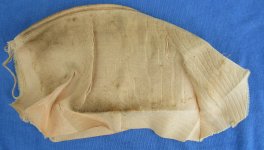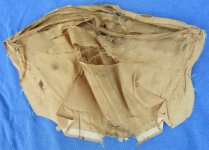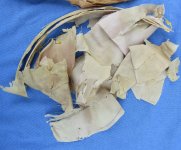Most of us are aware of the differences between pre WW1 officer helmets and those made during the War. A materials shortage produced the use of many ersatz solutions by manufacturers. The most obvious of these is the use of zinc "pot metal" fittings such as chin scales, spikes, spines etc. We also find combinations of zinc and brass on these wartime production helmets. For example, a pre war quality brass wappen on an officer helmet with zinc fittings. I have also seen a brass pearl ring on a zinc spike, there are many combinations. This post however, is going to show that the quality of the officer liner also suffered due to the mid war materials shortage. Some photos:

First, an example of the typical pre war officer silk liner. You can see the original colour of the cloth which was protected by the sweatband. There should always be 4 creases/folds in these liners which allow the silk to be stitched on to the sweatband. We see two of them here.

Our first wartime ersatz example. Because of the materials used, these have not held up well over 100+ years. I can only describe the material as some sort of thin ersatz" satin like" cloth. You can see the edges have been reinforced with cloth tape, so even when made, the delicacy of the fabric was obvious.

A second example, which has basically disintegrated after a century! Obviously, the quality was just not there. In my experience, the most common problem with pre war silk liners is the separation of threads in the ribbed silk cloth. Originally, the silk bag is tack stitched to the sweatband, it is common for this cotton thread to break or disintegrate so the silk becomes loose and in many cases lost. Silk was also not the only material used in pre war times. I have seen satin, linen and and a sort of canvas like cloth used.

First, an example of the typical pre war officer silk liner. You can see the original colour of the cloth which was protected by the sweatband. There should always be 4 creases/folds in these liners which allow the silk to be stitched on to the sweatband. We see two of them here.

Our first wartime ersatz example. Because of the materials used, these have not held up well over 100+ years. I can only describe the material as some sort of thin ersatz" satin like" cloth. You can see the edges have been reinforced with cloth tape, so even when made, the delicacy of the fabric was obvious.

A second example, which has basically disintegrated after a century! Obviously, the quality was just not there. In my experience, the most common problem with pre war silk liners is the separation of threads in the ribbed silk cloth. Originally, the silk bag is tack stitched to the sweatband, it is common for this cotton thread to break or disintegrate so the silk becomes loose and in many cases lost. Silk was also not the only material used in pre war times. I have seen satin, linen and and a sort of canvas like cloth used.
Last edited:
